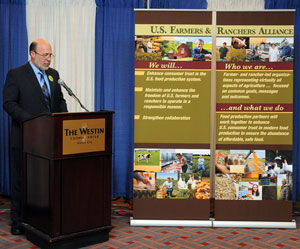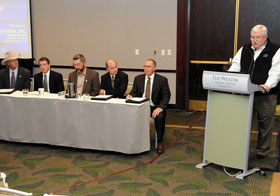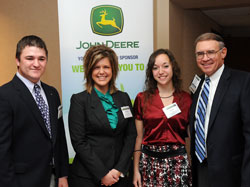The Thursday night banquet at NAFB honored many for outstanding and lifelong achievement in the industry.
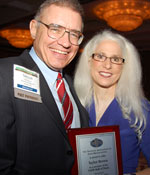 The NAFB Hall of Fame inducted two new members. Taylor Brown, Northern Ag Network, is past president of NAFB and the NAFB Foundation and has been called “Senator” for the past two years as he was elected to the Montana state legislature for a four year term. He and his wife Shannon were thrilled with the honor. Kinda young for this, don’t you think, Taylor?
The NAFB Hall of Fame inducted two new members. Taylor Brown, Northern Ag Network, is past president of NAFB and the NAFB Foundation and has been called “Senator” for the past two years as he was elected to the Montana state legislature for a four year term. He and his wife Shannon were thrilled with the honor. Kinda young for this, don’t you think, Taylor?
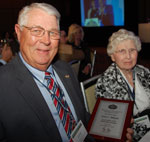 Also inducted into the Hall of Fame was Gene Millard, NAFB emeritus member and head of Millard Family Farms. Gene was a pioneer in NAFB’s sales and marketing efforts, and served as interim executive director for the organization for a little while. He brought his 90-something year old mother to help him celebrate the honor last night.
Also inducted into the Hall of Fame was Gene Millard, NAFB emeritus member and head of Millard Family Farms. Gene was a pioneer in NAFB’s sales and marketing efforts, and served as interim executive director for the organization for a little while. He brought his 90-something year old mother to help him celebrate the honor last night.
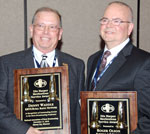 There were two different Meritorious Service Award winners this year, for the first time ever. The honorees this year were Denny Waddle of KRVN and former NAFB executive director Roger Olsen. Denny and Roger were both surprised by the recognition, which is always fun, although Roger noted that he never thought it was fair to surprise people with this award – and now he’s sure that it’s unfair!
There were two different Meritorious Service Award winners this year, for the first time ever. The honorees this year were Denny Waddle of KRVN and former NAFB executive director Roger Olsen. Denny and Roger were both surprised by the recognition, which is always fun, although Roger noted that he never thought it was fair to surprise people with this award – and now he’s sure that it’s unfair!
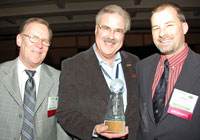 The New Holland Oscar in Agriculture Award was presented this year to Mark Oppold of RFD TV for his work covering the flooding in Tennessee earlier this year. Coverage of the flooding on RFD TV helped to raise about $50,000 to help those affected. NAFB is sincerely grateful to New Holland – represented here by the “retired” Gene Hemphill and Sean Dorosz, for sponsoring this award that recognizes the best of the best for excellence in farm broadcasting.
The New Holland Oscar in Agriculture Award was presented this year to Mark Oppold of RFD TV for his work covering the flooding in Tennessee earlier this year. Coverage of the flooding on RFD TV helped to raise about $50,000 to help those affected. NAFB is sincerely grateful to New Holland – represented here by the “retired” Gene Hemphill and Sean Dorosz, for sponsoring this award that recognizes the best of the best for excellence in farm broadcasting.
Check out more photos here:
NAFB Convention Photo Album
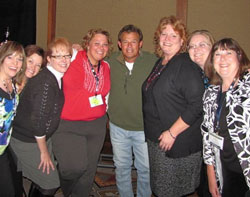 County music star Sammy Kershaw entertained the NAFB annual meeting Thursday night, bringing back an old tradition of live entertainment.
County music star Sammy Kershaw entertained the NAFB annual meeting Thursday night, bringing back an old tradition of live entertainment.
 The NAFB Hall of Fame inducted two new members. Taylor Brown, Northern Ag Network, is past president of NAFB and the NAFB Foundation and has been called “Senator” for the past two years as he was elected to the Montana state legislature for a four year term. He and his wife Shannon were thrilled with the honor. Kinda young for this, don’t you think, Taylor?
The NAFB Hall of Fame inducted two new members. Taylor Brown, Northern Ag Network, is past president of NAFB and the NAFB Foundation and has been called “Senator” for the past two years as he was elected to the Montana state legislature for a four year term. He and his wife Shannon were thrilled with the honor. Kinda young for this, don’t you think, Taylor? Also inducted into the Hall of Fame was Gene Millard, NAFB emeritus member and head of Millard Family Farms. Gene was a pioneer in NAFB’s sales and marketing efforts, and served as interim executive director for the organization for a little while. He brought his 90-something year old mother to help him celebrate the honor last night.
Also inducted into the Hall of Fame was Gene Millard, NAFB emeritus member and head of Millard Family Farms. Gene was a pioneer in NAFB’s sales and marketing efforts, and served as interim executive director for the organization for a little while. He brought his 90-something year old mother to help him celebrate the honor last night. There were two different Meritorious Service Award winners this year, for the first time ever. The honorees this year were Denny Waddle of KRVN and former NAFB executive director Roger Olsen. Denny and Roger were both surprised by the recognition, which is always fun, although Roger noted that he never thought it was fair to surprise people with this award – and now he’s sure that it’s unfair!
There were two different Meritorious Service Award winners this year, for the first time ever. The honorees this year were Denny Waddle of KRVN and former NAFB executive director Roger Olsen. Denny and Roger were both surprised by the recognition, which is always fun, although Roger noted that he never thought it was fair to surprise people with this award – and now he’s sure that it’s unfair! The New Holland Oscar in Agriculture Award was presented this year to Mark Oppold of RFD TV for his work covering the flooding in Tennessee earlier this year. Coverage of the flooding on RFD TV helped to raise about $50,000 to help those affected. NAFB is sincerely grateful to New Holland – represented here by the “retired” Gene Hemphill and Sean Dorosz, for sponsoring this award that recognizes the best of the best for excellence in farm broadcasting.
The New Holland Oscar in Agriculture Award was presented this year to Mark Oppold of RFD TV for his work covering the flooding in Tennessee earlier this year. Coverage of the flooding on RFD TV helped to raise about $50,000 to help those affected. NAFB is sincerely grateful to New Holland – represented here by the “retired” Gene Hemphill and Sean Dorosz, for sponsoring this award that recognizes the best of the best for excellence in farm broadcasting.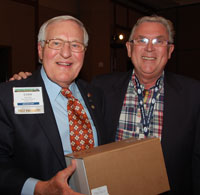 A brand new record was set for the NAFB Foundation’s annual fundraising auction Thursday night – $22,295! Not sure how much it beats the old record by, but last year the total was about $13,000, so this was a biggie.
A brand new record was set for the NAFB Foundation’s annual fundraising auction Thursday night – $22,295! Not sure how much it beats the old record by, but last year the total was about $13,000, so this was a biggie. Orion Samuelson, the original NAFB Foundation president, once again served as Master of Ceremonies for the auction. First he was honored with a special video presentation marking his 50 years at WGN. “I don’t want people to get confused that this is a retirement,” Orion said. “It isn’t. I’m having too much fun doing what I’m doing.”
Orion Samuelson, the original NAFB Foundation president, once again served as Master of Ceremonies for the auction. First he was honored with a special video presentation marking his 50 years at WGN. “I don’t want people to get confused that this is a retirement,” Orion said. “It isn’t. I’m having too much fun doing what I’m doing.”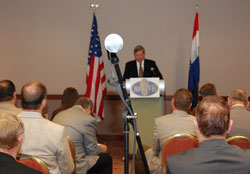 Farm broadcasters at NAFB Thursday went straight from Trade Talk to a 45 minute press conference with Agriculture Secretary Tom Vilsack.
Farm broadcasters at NAFB Thursday went straight from Trade Talk to a 45 minute press conference with Agriculture Secretary Tom Vilsack.  NAFB’s annual Trade Talk seemed to be one of the best ever, with many of both the exhibitors and the broadcasters claiming they had set all time interview records.
NAFB’s annual Trade Talk seemed to be one of the best ever, with many of both the exhibitors and the broadcasters claiming they had set all time interview records. 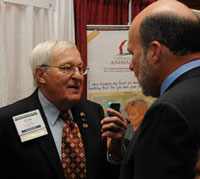 Trade Talk is really a unique event that has grown to be very popular with about 100 different companies, organizations and government agencies that come every year. Most of them have been participating in Trade Talk since it started 20 years ago. It gives the broadcasters and allied members an opportunity for real networking with each other.
Trade Talk is really a unique event that has grown to be very popular with about 100 different companies, organizations and government agencies that come every year. Most of them have been participating in Trade Talk since it started 20 years ago. It gives the broadcasters and allied members an opportunity for real networking with each other.
